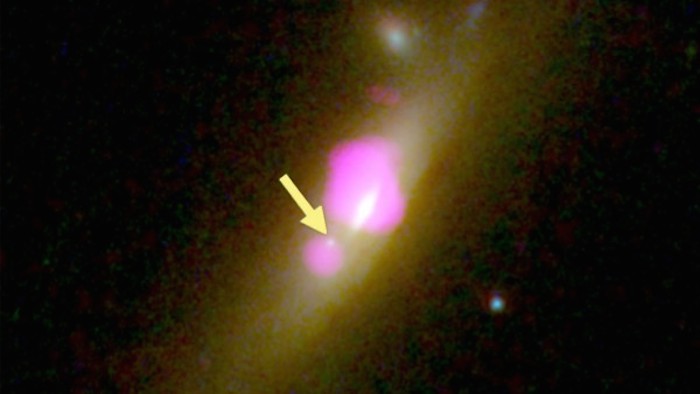.

The galaxy SDSS J1126+2944 showing both visible light (white) from the Hubble Space Telescope and x-rays (purple) taken with the Chandra X-ray Observatory. X-rays clearly reveal the galaxy’s twin black holes.
.
The mystery of the naked black hole
KISSIMMEE, FLORIDA—Most, if not all, galaxies have supermassive black holes at their centers surrounded by dense clouds of stars. Now, researchers have found one that seems to have lost almost its entire entourage. The team, which reported its find here today at the annual meeting of the American Astronomical Society, says it doesn’t know what stripped the stars away. But it has put forward a tantalizing possibility: The object could be an extremely rare medium-sized black hole, which theorists have predicted but observers have never seen.
The unusual black hole sits about 1 billion light-years from Earth in SDSS J1126+2944, a merger of two galaxies. Julie Comerford, an astronomer at the University of Colorado, Boulder, and colleagues first spotted it last year, “a small beauty mark off to one side” of the agglomeration, which hosts another giant black hole at its center,” she says. The two black holes, detected by NASA’s Chandra X-ray Observatory, are separated by 7000 light-years, but the larger one seems to have 500 times as many stars around it compared with the smaller one.
It’s possible, Comerford says, that somehow during the turmoil of the merger millions of years ago, gravity could have stripped the smaller black hole of its stars. But perhaps it just started out with fewer stars because it’s a different sort of black hole. (The Chandra observations don’t reveal the objects’ masses.)
Although supermassive black holes—which can weigh up to billions of times the mass of our sun—dominate galactic centers, galaxies also contain many smaller black holes, most weighing several times—or several tens of times—the sun’s mass. Theorists predict that there must be an intermediate class weighing between 100 and 1 million solar masses, but so far there is little firm evidence for their existence. Astronomers can see objects that could be intermediate mass black holes—something they call ultraluminous x-ray sources—but the problem is that “Chandra doesn’t tell us what they are,” says Eric Schlegel of the University of Texas, San Antonio, who is not involved in the study.
Comerford suggests that the beauty mark in SDSS J1126+2944 is something different: the central black hole of a dwarf galaxy, typically a hundredth of the size of a normal galaxy. If SDSS J1126+2944 is the result of the merger of a normal-sized galaxy with a dwarf galaxy, this could explain the naked black hole in the Chandra images.
It’s not an accepted fact that dwarf galaxies have intermediate black holes at their hearts. Although Schlegel says that SDSS J1126+2944 does look like the result of a merger, and so Comerford’s team isn’t seeing an ultraluminous x-ray source, he says it’s too early to discount the possibility that it’s just a normal supermassive black hole that got stripped. “When you collide these things [galaxies], stuff goes everywhere.”
Quelle: AAAS
4092 Views
